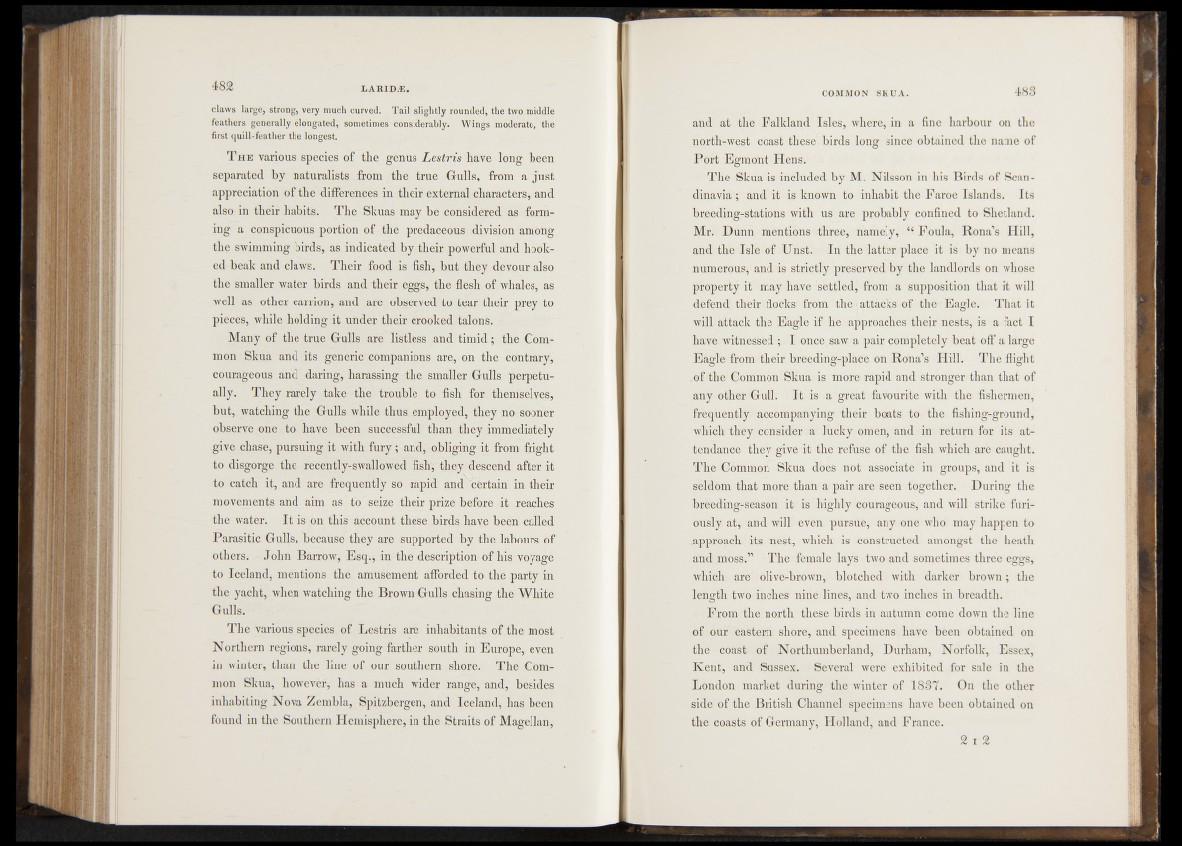
claws large, strong, very much curved. Tail slightly rounded, the two. middle
feathers generally elongated, sometimes considerably. Wings moderate, the
first quill-feather the longest.
T he various species of the gènus Lestris have long been
separated by naturalists from the true Gulls, from a just
appreciation of the differences in their external characters, and
also in their habits. The Skuas may be considered as forming
a conspicuous portion of the predaceous division among
the swimming birds, as indicated by their powerful and hooked
beak and claws. Their food is fish, but they devour also
the smaller water birds and their eggs, the flesh of whales, as
well as other carrion, and are observed to tear their prey to
pieces, while holding it under their crooked talons. -.
Many of the true Gulls are listless and timid; the Common
Skua and its generic companions are, on the contrary,
courageous and daring, harassing the smaller Gulls perpetually.
They rarely take the trouble to fish for themselves,
but, watching the Gulls while thus employed, they no sooner
observe one to have been successful than they immediately
give chase, pursuing it with fury; and, obliging it from fright
to disgorge the recently-swallowed fishy they descend after it
to catch it, and are frequently so rapid and^cêrtain' in their
movements and aim as to seize their prize before it reaches
the water. I t is on this account these .birds have beén called
Parasitic Gulls, because they are supported by the labours of
others. John Barrow, Esq., in the description of his voyage
to Iceland, mentions the amusement afforded to the party in
the yacht, when watching the Brown Gulls chasing the White
Gulls.
The various species of Lestris are inhabitants of the most
Northern regions, rarely going farther south in Europe, even
in winter, than the line of our southern shore. The Common
Skua, however, has amuch wider range, and, besides
inhabiting Nova Zembla, Spitzbergen, and Iceland, has been
found in the Southern Hemisphere, in the Straits of Magellan,
and at the Falkland Isles, where, in a fine harbour on the
nqrth-west coast these birds long since obtained the name of
Port Egmont Hens.
The Skua is included by M. Nilsson in his Birds of Scandinavia
; and it is known to inhabit the Faroe Islands. Its
breeding-stations with us are probably confined to Shetland.
Mr. Dunn mentions three, namely, “ Foula, Rona’s Hill,
and the Isle of Unst. In the latter place it is - by no means
numerous^ and is strictly preserved by the landlords on whose
property it may have Jsettled, from a supposition that it will
defend their flocks from the‘.attacks of tho Eagle. That it
will attack the Eagle if he approaches their nests, is a fact I
have witnessed; I once.saw a pair completely beat off a large
Eagle from their breeding-place on Rona’s Hill. The flight
.of the Common Skua is more rapid and stronger than that of
any other Gull. I t is a great favourite with the fishermen,
frequently accompanying their boats to the fishing-ground,
which they consider a lucky, omen, and in return for its attendance
they give it the refuse of the fish which are caught.
The Common Skua does not associate in groups, and it is
seldom that more than a pair are seen together. During the
breeding-season it is highly courageous, and will strike furiously
at, and will even pursue, any one who may happen to
Approach its nest, which is constructed amongst the heath
and moss.” The female lays two and sometimes three eggs,
which are olive-brown, blotched with darker brown; the
length two inches nine lines, and. two inches in breadth.
From the north these birds in autumn come down the line
of our eastern shore, and specimens have been obtained on
the coast of Northumberland, Durham, Norfolk, Essex,
Kent, and Sussex. j| Several were exhibited for sale in the
London market during the winter of 1887. On the other
side of the British Channel specimens have been obtained on
the coasts of Germany, Holland, and France.
2 i 2